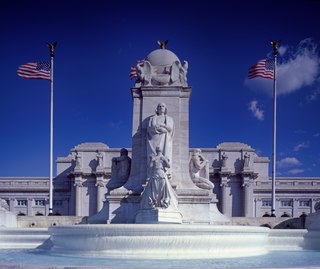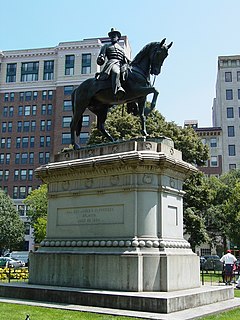
Leo Friedlander was an American sculptor, who has made several prominent works. Friedlander studied at the Art Students League in New York City, the Ecole des Beaux Arts in Brussels and Paris, and the American Academy in Rome. He was an assistant to the sculptor Paul Manship and taught at the American Academy in Rome and at New York University, where he headed the sculpture department. He was also president of the National Sculpture Society. In 1936, he was elected into the National Academy of Design as an Associate member, and became a full Academician in 1949.

Henry Merwin Shrady was an American sculptor, best known for the Ulysses S. Grant Memorial on the west front of the United States Capitol in Washington, D.C.

Columbus Fountain also known as the Columbus Memorial is a public artwork by American sculptor Lorado Taft, located at Union Station in Washington, D.C., United States. A centerpiece of Columbus Circle, Columbus Fountain serves as a tribute to the explorer Christopher Columbus. The unveiling in 1912 was celebrated all over Washington, DC over the course of three days with parades, concerts and fireworks gathering tens of thousands of people from all over the world.

The Daniel Webster Memorial is a monument in Washington, D.C. honoring U.S. statesman Daniel Webster. It is located near Webster's former home at 1603 Massachusetts Avenue Northwest, beside Scott Circle at the intersection of Massachusetts Avenue and Rhode Island Avenue.
Leo Lentelli was an Italian sculptor who immigrated to the United States. During his 52 years in the United States he created works throughout the country, notably in New York and San Francisco. He also taught sculpture.

Guglielmo Marconi is a public artwork by Attilio Piccirilli, located at the intersection of 16th and Lamont Streets, N.W., in the Mount Pleasant neighborhood of Washington, D.C., United States. It stands as a tribute to Italian inventor Guglielmo Marconi. It was paid for by public subscription and erected in 1941. The artwork was listed on both the District of Columbia Inventory of Historic Sites and the National Register of Historic Places in 2007. It is a contributing property in the Mount Pleasant Historic District. The monument was originally surveyed as part of the Smithsonian's Save Outdoor Sculpture! survey in 1994.

Francis Asbury, also known as the Francis Asbury Memorial, is a public equestrian statue, by American artist Augustus Lukeman, located at 16th Street and Mt. Pleasant Street, Northwest, Washington, D.C., in the Mount Pleasant neighborhood.

Dante Alighieri, is a public artwork by Italian artist Ettore Ximenes, located at Meridian Hill Park in Washington, D.C., United States. Dante Alighieri was originally surveyed as part of the Smithsonian Institution's Save Outdoor Sculpture! survey in 1994. The monument is a tribute to Italian poet Dante Alighieri.

The Luther Monument is a public artwork located at Luther Place Memorial Church in Washington, D.C., United States. The monument to Martin Luther, the theologian and Protestant Reformer, is a bronze full-length portrait. It is a copy of the statue created by Ernst Friedrich August Rietschel as part of the 1868 Luther Monument in Worms, Germany. The monument was originally surveyed as part of the Smithsonian's Save Outdoor Sculpture! survey in 1993.

Major General James B. McPherson is a public artwork by American artist Louis Rebisso, located at McPherson Square in Washington, D.C., United States. Major General James B. McPherson was originally surveyed as part of the Smithsonian's Save Outdoor Sculpture! survey in 1993. The monument is a bronze equestrian statue of Civil War hero James B. McPherson. The statue is a contributing monument to the Civil War Monuments in Washington, DC, of the National Register of Historic Places.

Edmund Burke is a bronze full length statue of Irish statesman, author, orator, political theorist and philosopher Edmund Burke by British artist James Havard Thomas. The original is in Bristol, England, with a second cast on Massachusetts Avenue at 11th and "L" Streets, NW, in Washington, D.C., United States.

Major General George Henry Thomas, also known as the Thomas Circle Monument, is an equestrian sculpture in Washington, D.C. that honors Civil War general George Henry Thomas. The monument is located in the center of Thomas Circle, on the border of the downtown and Logan Circle neighborhoods. It was sculpted by John Quincy Adams Ward, best known for his work on the statue of George Washington in Wall Street, Manhattan. Attendees at the dedication in 1879 included President Rutherford B. Hayes, Generals Irvin McDowell, Philip Sheridan, and William Tecumseh Sherman, senators and thousands of soldiers.

Brevet Lt. General Winfield Scott is an equestrian statue in Washington, D.C., that honors career military officer Winfield Scott. The monument stands in the center of Scott Circle, a traffic circle and small park at the convergence of 16th Street, Massachusetts Avenue and Rhode Island Avenue NW. The statue was sculpted by Henry Kirke Brown, whose best-known works include statues of George Washington in New York and Nathanael Greene in Washington, D.C. It was the first of many sculptures honoring Civil War generals that were installed in Washington, D.C.'s traffic circles and squares and was the second statue in the city to honor Scott.

The statue of John Aaron Rawlins, a United States Army general who served during the Civil War and later as Secretary of War, is a focal point of Rawlins Park, a small public park in Washington, D.C.'s Foggy Bottom neighborhood. It was installed in 1874, but relocated several times between 1880 and 1931. The statue was sculpted by French-American artist Joseph A. Bailly, whose best known work is the statue of George Washington in front of Independence Hall in Philadelphia.

The Albert Pike Memorial is a public artwork in Washington, D.C. honoring Albert Pike (1809–1891), a senior officer of the Confederate States Army as well as a poet, lawyer, and influential figure in the Scottish Rite of freemasonry. The memorial, which now only includes the base and Goddess of Masonry sculpture, is sited near the corner of 3rd and D Streets NW in the Judiciary Square neighborhood. The memorial's two bronze figures were sculpted by Gaetano Trentanove, an Italian-American artist responsible for another Washington, D.C. sculptural landmark, the Daniel Webster Memorial. The dedication ceremony in 1901 was attended by thousands of Masons who marched in a celebratory parade.

George Washington is an outdoor equestrian statue by the Scottish-American sculptor J. Massey Rhind located in Washington Park in Newark, New Jersey. It depicts General George Washington saying farewell to the troops of the Continental Army on November 2, 1783, and was dedicated on the anniversary of that event in 1912.
















